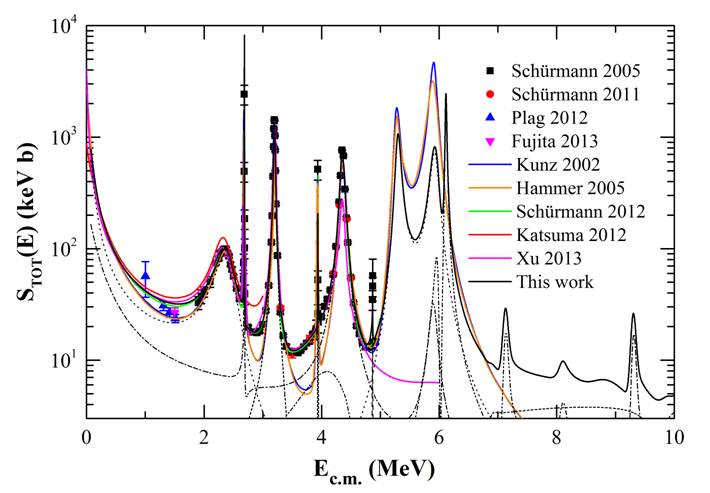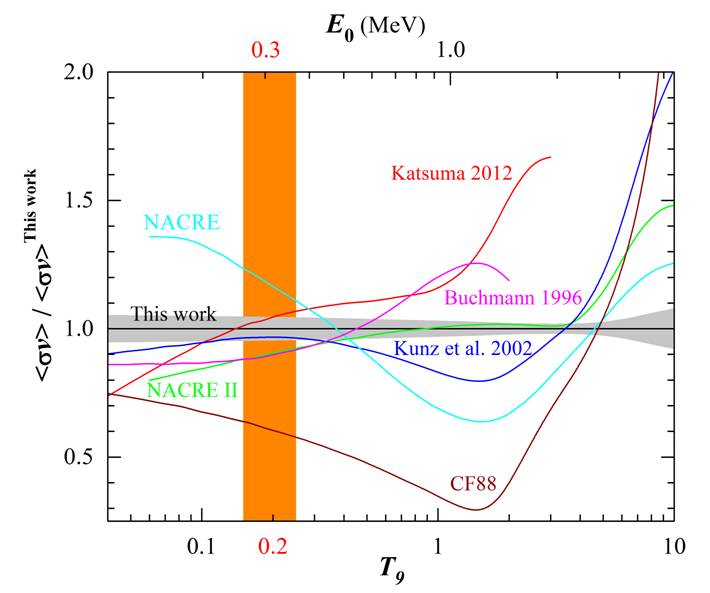






Research progress on astrophysical S factor and reaction rate for 12C(α,γ)16O in stellar helium burning
Based on a new multilevel and multichannel reduced R-matrix theory for applications in nuclear astrophysics, researchers from Shanghai Institute of Applied Physics, CAS and Tsinghua University have obtained an accurateand self-consistent astrophysical S factor and reaction rate of 12C(α,γ)16O, by a global fitting for almost all available experimental data of 16O system. The series work were published in Astrophysical Journal Letters (ApJ, 817, L5 (2016)) and Physical Review C (PRC 92,045802 (2015)), for the first time, which could meet the required precision of stellar models in theoretical extrapolation.
During stellar helium burning, the rates of 3α and the 12C(α,γ)16O reaction, in competition with one another, determine the timescale of this phase and the relative abundances of 12C and 16O in a massive star. The abundance ratio is the beginning condition of the following nucleo synthesis and star evolution of massive stars, which are extremely sensitive to the rate of 12C(α,γ)16O reaction at T9 = 0.2. William A. Fowler, a Nobel laureate in physics in 1983, definitely held a view that the abundance ratio of 12C to 16O and the solar neutrino problem are the most basic questions of nuclear astrophysics. The most direct and trustworthy way to obtain the astrophysical reaction rate of the 12C(α,γ)16O reaction is to measure the S factor for that reaction to as low energy as possible and to extrapolate to energies of astrophysical interest.
Recently, Mr. Zhendong An, Prof. Yu-Gang Ma and his team at SINAP, together with Prof. Zhenpeng Chen from Tsinghua University, have developed a multilevel and multichannel reduced R-matrix theory based on the classical R-matrix theory of Lane and Thomas, for low-energy nuclear reaction. With the coordination of covariance statistics and error-propagation theory, a global fitting for almost all available experimental data of 16O system has been multi-iteratively analyzed by the powerful code. The extrapolated S factor of 12C(α,γ)16O was obtained with a recommended value Stot (0.3MeV) = 162.7±7.3 keV b. And the reaction rates of 12C(α,γ)16O for stellar temperatures between 0.04 ≤T9≤ 10 are provided in a tabular form and by an analytical fitting expression. At T9 = 0.2, the reaction rate is (7.83 ± 0.35) × 1015 cm3 mol?1 s?1, where stellar helium burning occurs. These results could help scientists understand the nucleo synthesis of the intermediate-mass elements to iron element, the reaction mechanism of s-process, r-process, and p-process, and the evolution of a massive stars.
The undergoing project of Shanghai Laser Electron Gamma Source facility (SLEGS) at SSRF-II plans to allow a measurement of cross sections in the pb region, and hopes to resolve the "holy grail" problem of 12C(α,γ)16O reaction experimentally.
This work is partially supported by the National Natural Science Foundation of China and the 973 project.
Contact
Yugang Ma
Shanghai Institute of Applied Physics (SINAP), CAS
Email: mayugang@sinap.ac.cn

FIG 1. The Best fits to the Stot data.
FIG 2、Comparisons of the astrophysical reaction rate of 12C(α, γ)16O normalized to our new recommended rate.